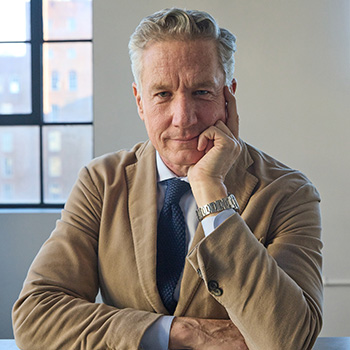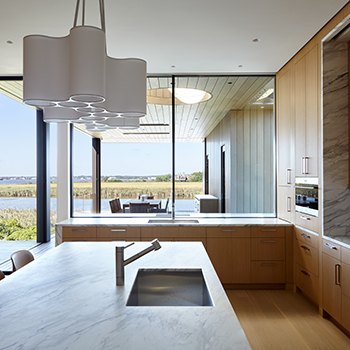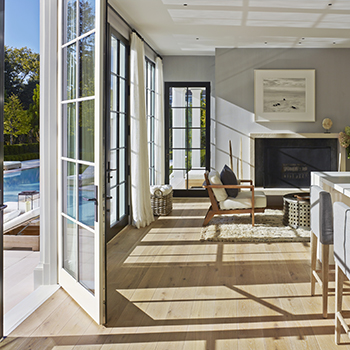The grandson of Dutch American farmers from Iowa, Brian Sawyer ’84 grew up with an appreciation for history, the natural world, and traditional architecture and gardens. He was drawn to Wabash for its simplicity, beauty, and charm. For 25 years, he and his business partner John Berson have led an architecture, landscape architecture, and interior design firm in New York City.
 Brian Sawyer ’84 spent many happy moments of his childhood alongside his mother exploring Conner Prairie, small museums around Indiana, and the vast woodlands next to his home in Indianapolis.
Brian Sawyer ’84 spent many happy moments of his childhood alongside his mother exploring Conner Prairie, small museums around Indiana, and the vast woodlands next to his home in Indianapolis.
“I was fascinated with everything,” Sawyer says. “I was always collecting plants, rocks and objects found in the woods and bringing things back to the house—minerals, mosses, sapling trees, ferns, bulbs, amphibians, leaves and odd funghi.”
He was particularly interested in the collection of orchids at the greenhouse at the Indianapolis Museum of Art (now Newfields). As a result, 13-year-old Sawyer started his own collection of orchids.
“My amazing father partitioned our basement so that my brothers and I had our own hobby spaces and workshops” he continues. “Mine included a rock polishing station, a printing press, and racks of plants under artificial lights. There were so many plants that eventually, my father built a greenhouse for me.”
As a music major and biology minor at Wabash, Sawyer was given the unique opportunity to oversee the College’s greenhouse too.
“Because of the grace of (Professor of Biology) David Polley, I was given management responsibility of the greenhouse. It was this special refuge for me,” says Sawyer. “I moved my orchid collection to campus and overran it with all my plants.”
Polley viewed the relationship as less about grace and more about what Sawyer brought to the place.
“It was a pretty sad greenhouse,” says Polley. “He brought his orchids, and it became this vibrant place of color. You could see by the way he set up his collection that he was artistic. It became a place people could visit to get a break from the gray winter skies.”
Sawyer’s favorite classes at Wabash included Polley’s botany course, ecology, classics, and Professor of Music David Greene’s philosophy and music course, which Sawyer describes as “the link between it all.”

It was Greene who helped Sawyer unearth his calling when he suggested Sawyer consider graduate work in design. That led to Sawyer getting a master’s in landscape architecture at University of Virginia. He then spent several years working for the major New York City architecture firm Robert A.M. Stern Architects.
“I was immersed in landscape design and eventually ran the Landscape Architecture Department,” he says. “I started my (Sawyer|Berson) firm because I wanted to design the houses as well.
“There are not many people doing what we are doing,” Sawyer continues. “Architecture, landscape architecture and interiors—I am responsible for creating the initial designs for most everything. I can see the entire house, its style, its plan, and then the landscapes surrounding it.”
Sawyer, his partner, John Berson, and their team of 36 architects, landscape architects and interior designers view the holistic design approach as the most important part of their process.
“What we care about are beautiful and appropriate environments; it’s that simple,” says Sawyer. “For a house that means comfortable, beautiful, but highly functional. And for gardens it’s not just function and beauty, but layers of meaning and purpose both aesthetic and ecological. This is our firm’s philosophy and our clients expect us to provide this uniquely to every project.”
A typical day at the office might include client and consultant meetings as well as team staff meetings for design or project strategies on various houses, apartments, gardens and interiors. Some days there will be a charrette—an intense design session which may go into the wee hours with team members drawings and rendering until it is perfect.

The open-concept design of their studio on 19th and Park Avenue South in Manhattan allows for easy networking and cross-dialogue among departments and coworkers.
“What I like most is collaboration and working with my partner and our various teams,” Sawyer says. “The process and working with people who I respect and admire is what gets me to work every day.”
The task of bringing different ideas to the table every time comes with each new project.
“The bad thing is we didn’t design a widget, because we could be retired at this point,” Sawyer says with a laugh. “The good thing is that we didn’t design a widget because every project is new start. But, you can get caught up in applying the same methods to new problems. The challenge is creating new approaches and ideas so that every project is unique.
“You have to push yourself and push yourself and push yourself,” he concludes. “And if you don’t second-guess yourself, nobody else will, and you will never advance things that way. You have to constantly think about how you can do it better.”
To honor his former music professors Fred Enenbach and David Greene, Sawyer has created the Enenbach-Greene Fine Arts Internship. It provides a summer internship opportunity in the fine arts or the in the College’s humanities and fine arts departments.